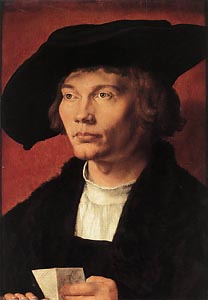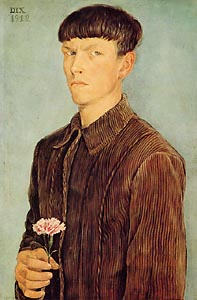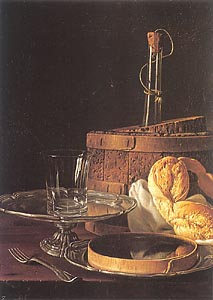| |
Manfred Juergens is a German artist residing
and
working
in
Hamburg. His
oeuvre covers portraiture, still lifes and landscapes.

According to the artist,
there are two main influences on
his
work.
He has admired the art of the Old Masters since his
youth, and even copied some works in order to get a feel for
how painting was approached many centuries ago. He has also
always been fascinated by the 20th century art of Neue Sachlichkeit,
works produced during the volatile years of the Roaring
Twenties. Above all, Juergens
is impressed with the art of
Albrecht Dürer
and
Otto Dix .Close study of
their work has inspired him to adopt the Mische Technique,
which he now uses in all of his paintings.
The Mische (or Mixed) Technique dates back to Flemish painter
Jan van Eyck (c1395-1441).
Artists prior to this time painted with Egg Tempera,
essentially pigment mixed with egg binder. In
Van Eyck's
technique the artist used multiple layers of transparent
oil
color glazes, alternating with white egg tempera applied for
highlights. The introduction of oil combined with the tempera
facilitated the rendering of very fine detail and realism, which became main characteristics of the Northern Renaissance.
The artists of northern Europe quickly learned that the usage
of oils enhanced the color of their pigments and gave them
flexibility for creating larger works. The Mixed Technique became
a mainstay for
Dürer,
Hans Holbein the Younger
and other northern
Masters. Van Eyck's major
works all were painted in the 1430s. It was several
decades later before his tempera and oil technique was
adopted by Italian artists, notably by the
Venetian master
Giovanni Bellini . Italian artists soon
were experimenting with their own recipes. Artists began adding
litharge (white lead) to their glazes, which promotes oxidation and
thus faster drying.
Leonardo added bees wax in order to
prevent darkening of the painting over time. Soon the
introduction of the plant resins damar and mastic allowed
artists to simplify and speed up the process of completing a
painting. By the mid 16th
Century, all artists had stopped using
straight Egg Tempera in favor of some technique incorporating oils.
Variations of the Mixed Technique remained the fundamental
methods of oil painting used by most artists until the mid 1800s,
when paint in tubes became available and the Modernists
abandoned traditional approaches in favor of
Direct Painting.
Manfred Juergens' admiration of Otto Dix stems from the
 latter
artist's study and use of the Mixed Technique. Dix also
developed a deep appreciation for the Old Masters as a youth .
Although his output is diverse and introduces many Expressionist
elements, it includes many remarkable works in gritty
Realism, all painted with the use of oil glazes. He found
inspiration in the art of German Masters , especially
Dürer
and
Hans Baldung Grien
.Dix, more than any other artist in the 1920s, recorded
what he saw, whether in the streets of Berlin, in clubs and
brothels, and in his memories of his time in the trenches. His
exemplary works of the late 1920s, such as The War
and Metropolis, made a virtuoso use of the triptych
format, paying homage to the masterful composition in great
altarpieces of the 15th and 16th centuries. Yet it is in his
portraiture that Dix could couple his incisive eye with the unheimlich (uncanny), a central theme of Neue Sachlichkeit, to
capture an insightful perception of his sitter. Quite often
the resulting painting turned out less than flattering.
Although none of Mr. Juergens' subjects would feel slighted by
his portrait of them, he does share with Dix the ability to
perceive. Yet what he sees today is quite different than what
Dix witnessed in
Weimar Germany. latter
artist's study and use of the Mixed Technique. Dix also
developed a deep appreciation for the Old Masters as a youth .
Although his output is diverse and introduces many Expressionist
elements, it includes many remarkable works in gritty
Realism, all painted with the use of oil glazes. He found
inspiration in the art of German Masters , especially
Dürer
and
Hans Baldung Grien
.Dix, more than any other artist in the 1920s, recorded
what he saw, whether in the streets of Berlin, in clubs and
brothels, and in his memories of his time in the trenches. His
exemplary works of the late 1920s, such as The War
and Metropolis, made a virtuoso use of the triptych
format, paying homage to the masterful composition in great
altarpieces of the 15th and 16th centuries. Yet it is in his
portraiture that Dix could couple his incisive eye with the unheimlich (uncanny), a central theme of Neue Sachlichkeit, to
capture an insightful perception of his sitter. Quite often
the resulting painting turned out less than flattering.
Although none of Mr. Juergens' subjects would feel slighted by
his portrait of them, he does share with Dix the ability to
perceive. Yet what he sees today is quite different than what
Dix witnessed in
Weimar Germany.
The second
important area of work for Manfred Juergens are his
still lifes, which he approaches with the same fervor
as his portraits. However on this theme, other than a few
works by
Dürer,
artists must look to later periods to find classical
references. Caravaggio was the first master to seriously
undertake the theme of still lifes as the subject of the
painting. His work is noted for its vivid realism,
including details of plant disease and pests, as well as
deformities in fruit and vegetables. His art informed
generations of
Italian Baroque artists, as well as important
groups of painters in Spain . The Spanish groups, known as
Bodegón artists, worked less
with floral subjects and rich banquets, more with raw
vegetables, undressed game, and simple tableware. Notable among of the Bodegón artist
were
Francisco de Zurbarán,
Diego Velázquez,
Juan
Sánchez Cotán
of the 17th Century,
and later
Luis Melendez of the 18th
Century. During the Dutch Golden Age, of the 17th Century,
there were many accomplished artists working with still lifes.
The most notably was
Willem Claesz Heda, known for
his sumptuous arrangements. The Dutch point of view celebrated
the prosperity derived from their success as a trading nation
.
are his
still lifes, which he approaches with the same fervor
as his portraits. However on this theme, other than a few
works by
Dürer,
artists must look to later periods to find classical
references. Caravaggio was the first master to seriously
undertake the theme of still lifes as the subject of the
painting. His work is noted for its vivid realism,
including details of plant disease and pests, as well as
deformities in fruit and vegetables. His art informed
generations of
Italian Baroque artists, as well as important
groups of painters in Spain . The Spanish groups, known as
Bodegón artists, worked less
with floral subjects and rich banquets, more with raw
vegetables, undressed game, and simple tableware. Notable among of the Bodegón artist
were
Francisco de Zurbarán,
Diego Velázquez,
Juan
Sánchez Cotán
of the 17th Century,
and later
Luis Melendez of the 18th
Century. During the Dutch Golden Age, of the 17th Century,
there were many accomplished artists working with still lifes.
The most notably was
Willem Claesz Heda, known for
his sumptuous arrangements. The Dutch point of view celebrated
the prosperity derived from their success as a trading nation
.
With regard to animal subjects, Mr. Juergens treats them with
the same attention to detail as his portraits. Georg, the roster, shows that he has more dignity than the
low-life woman, laughing in the background. Treated in the
classic portraiture style of the German Masters, this painting
demonstrates a juxtaposition and irony that would be very
typical of a Neue Sachlichkeit work.
The art of Manfred Juergens is related to the current movement
of Classical Realism, although as an artist he has developed
his skills independent of any atelier, and his choice of
techniques predates academic art . His influences belong to
the traditions of European art, yet the naturalism and clarity
of his aesthetics brings to mind Andrew Wyeth
or the Egg Tempera art of
High Realism . Painting with the Mische Technique requires
considerable planning,
patience and weeks, if not months, of careful work. The
question rises as to why an artist would choose a method of
painting with such a high degree of difficulty. Perhaps the answer, at
least in Manfred Juergens' case, is to bring oneself
spiritually back in contact with the masters of the
Renaissance, and the great continua of Realism in painting. It is a true labor of love,
one that can be
appreciated by us all .
Manfred Juergens'
Gallery
Artist's Web Site:
http://www.m-w-juergens.de/index-e.html
|
|